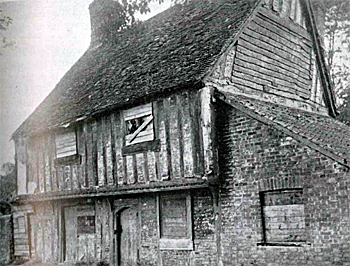Tempsford Chantry

The Chantry House in 1937 from the Bedfordshire Magazine
A fifteenth century chantry house once stood on Mill Lane, close to the north and west walls of the rectory garden. Old photographs show it to have been a half-timbered Tudor style building with an overhanging upper story. It had been used to house farm workers since the Reformation but fell into such a state of dereliction that it was eventually demolished in March 1939.
For those with property, chantries were a popular form of church giving throughout the fourteenth and early fifteenth centuries. A chantry was essentially an endowment granted to a church and which guaranteed the chanting of masses and offering of prayers for the soul of the benefactor. Usually the endowment took the form of money but sometimes income from certain lands or properties might be granted to fund the chantry. The tradition came to an end with the coming of the Reformation in the 1530s.
Tempsford Chantry is thought to date from sometime between 1449 and 1482. It was founded by endowments made in the wills of Thomas Bulle and Sir John Mytton although no traces of these wills have ever been found. Between them, Bulle and Mytton left lands in Sandy, Tempsford and Everton which they hoped would be used to employ and house a priest whose job it would be to ensure that the appropriate masses for their souls would be performed. Very little is known about these two men, Sir John Mytton in particular. Henry Chapman speculates in his history of the chantry that Bulle may have been the same Thomas Boll or Bole who was presented as rector to Tempsford in 1421. This man’s name appears on a list of men pardoned by Henry VI for their part in a rebellion of 1449, suggesting to Chapman that the chantry may have been founded as a sort of voluntary penance to sooth the consciences of the two men.
The earliest documentary evidence for the existence of a chantry at Tempsford is a 1482 deed which mentions property adjoining the chantry lands. A decree of arbitration held at Magdalen College, Oxford, reveals that by 1517 the chantry may already have been the subject of allegations of misuse. In this document several local men – named as Thomas Sheffield, William Hawes, Thomas Norman, John Cooper, John Sprynge, John Fysher and Robert Cooper – accused the then rector, Thomas Philipe, of receiving the income from the chantry lands without ensuring that the chantry was performed according to the terms specified at its foundation. The arbitrators eventually decreed that a new chantry priest would have to be appointed and funded solely from the sale of timber growing on chantry lands. The new priest, they stated, would have to be learned enough to set up a free Grammar School in the chantry house but willing to accept a yearly salary of just £10.
It seems likely that a suitable priest was soon in place as there are no further documentary references to the chantry until the Reformation. Following the dissolution of the monasteries, parliament granted the endowments of all chantries to Henry VIII and commissioners were appointed to survey the King’s new holdings. The commissioners arrived in Tempsford in 1548 and their report still survives at the National Archives. They noted that at this time the total yearly sum accruing from the rents owed to the chantry was just £6 11s 8d. There were no goods or church plate to speak of and the current chantry priest, Edward Pynder, was aged sixty and “but meanly learned, not able to serve a cure and hath no other living but only the chantry.” They noted that the Grammar School had been closed since the previous Michaelmas and no charity had been given to the poor for five years.
Following the commissioner’s report the chantry was swiftly broken up. Pynder was given a pension of £5 a year and the chantry lands were leased firstly to Thomas Maria Wingfield and then to Richard Hacklete before eventually being swallowed up by the Tempsford Hall Estate. At some point the chantry house was divided into two small cottages and used to house local farm workers. However, by 1927 when a surveyor arrived to assess its rateable value, he found “2 Very Old cottages knocked into one”. He noted that the property was owned by Mrs Stuart of Tempsford Hall but leased to Harold Thurley for a rent of £8 a year. It had four bedrooms and a large garden but no running water. The electoral registers show that the Thurleys remained in the former chantry house until about 1932 but after they left it seems to have remained empty until it was demolished in 1939. Its timbers were used for an addition to 15 Church Street.